21
Ivabradine Clinical Trials Proving Its Effectiveness in Heart Failure and Angina
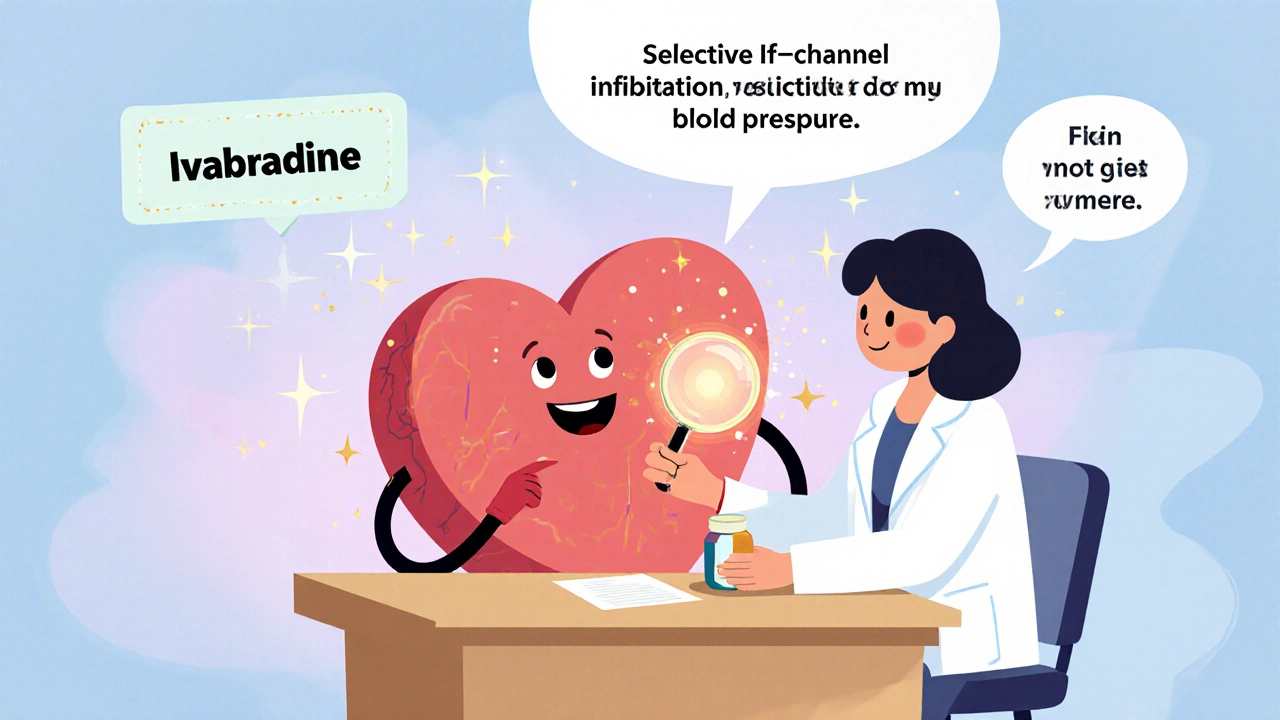
Ivabradine Clinical Trial Impact Calculator
SHIFT Trial Overview
Based on the landmark SHIFT trial (Systolic Heart failure treatment with the If inhibitor ivabradine Trial), which enrolled 6,558 patients with chronic HFrEF (LVEF ≤35%) on optimal therapy.
Key finding: Ivabradine reduced the primary endpoint (cardiovascular death or hospitalization for worsening heart failure) by 18% (HR 0.82; 95% CI 0.71-0.94; p=0.005).
Calculate Potential Impact
Results
Based on SHIFT trial results: 18% reduction in primary endpoint (cardiovascular death or hospitalization for worsening heart failure).
How to Interpret Results
In the SHIFT trial, 18% fewer patients experienced the primary endpoint (cardiovascular death or heart failure hospitalization) when treated with Ivabradine compared to placebo. This calculator estimates how many patients might benefit from Ivabradine based on your inputs.
Note: The baseline event rate should reflect the observed event rate in similar patients without Ivabradine treatment. The calculation assumes a constant treatment effect (18% reduction) across all patient groups.
What is Ivabradine?
Ivabradine is a selective I_f‑channel inhibitor that reduces heart rate without lowering blood pressure or contractility. It works by slowing the pacemaker activity in the sinus node, allowing the heart to fill more efficiently between beats. First approved in Europe in 2005 for chronic stable angina, it later gained approval for heart failure with reduced ejection fraction (HFrEF) in the United States (2021).
The drug’s unique mechanism makes it a valuable add‑on when beta‑blockers are insufficient or poorly tolerated. By targeting the sinus node specifically, ivabradine avoids many of the side‑effects seen with traditional negative‑inotropes.
Why Clinical Trials Matter
Physicians and patients alike ask, “Does it really work?” Randomised controlled trials (RCTs) provide the highest level of evidence because they compare outcomes in patients who receive the drug versus those who get a placebo or standard care. For Ivabradine, three pivotal Phase III studies-SHIFT, BEAUTIFUL, and SIGNIFY-have shaped prescribing guidelines worldwide.
SHIFT (Systolic Heart failure treatment with the If inhibitor ivabradine Trial)
SHIFT was a double‑blind, multicentre trial that enrolled 6,558 patients with chronic HFrEF (LVEF ≤35%) who were already on optimal guideline‑directed therapy, including beta‑blockers. Participants had a resting heart rate ≥70 bpm.
- Primary endpoint: composite of cardiovascular death or hospitalisation for worsening heart failure.
- Median follow‑up: 22.9 months.
- Result: Ivabradine reduced the primary endpoint by 18 % (HR 0.82; 95 % CI 0.71-0.94; p = 0.005).
- Key secondary outcomes: a 26 % reduction in heart‑failure hospitalisations and a modest 9 % drop in cardiovascular mortality.
Importantly, the safety profile was favourable. The most common adverse event was luminous phosphenes (visual disturbances), reported in 11 % of patients, and only 1 % discontinued because of it.
BEAUTIFUL (Bela Tic) - Evaluating the I_f Inhibitor Ivabradine in Patients With Coronary Artery Disease and Left‑Ventricular Dysfunction)
BEAUTIFUL enrolled 10,917 patients with stable coronary artery disease (CAD) and left‑ventricular ejection fraction <45 %.
- Heart rate criterion: ≥70 bpm at baseline.
- Primary composite endpoint: cardiovascular death, hospital admission for acute coronary syndrome, or myocardial infarction.
- Overall trial result: no significant difference in the primary composite.
- Sub‑analysis of the 1,942 patients with heart rate ≥75 bpm showed a 21 % reduction in cardiovascular death or myocardial infarction (HR 0.79; p = 0.04).
These findings highlighted that the benefit of Ivabradine is most pronounced in patients with higher baseline heart rates, reinforcing the drug’s rate‑control rationale.

SIGNIFY (Study Assessing the Morbidity‑Mortality Benefits of Ivabradine in Patients With Coronary Disease)
SIGNIFY was designed to test whether Ivabradine could improve outcomes in patients with chronic stable angina without heart failure. Over 19,000 participants with CAD and resting heart rate ≥70 bpm were randomised.
- Primary composite endpoint: cardiovascular death, non‑fatal myocardial infarction, or disabling stroke.
- Result: No significant difference in the primary endpoint (HR 0.97; p = 0.55).
- Notable finding: In the subgroup with heart rate ≥75 bpm, there was a small but statistically significant reduction in the combined endpoint (HR 0.89; p = 0.02).
- Safety: Similar rates of adverse events across groups, with modest increases in bradycardia (2.7 % vs 1.8 %).
SIGNIFY taught clinicians that Ivabradine should not be used routinely for angina alone unless patients have a high resting heart rate despite optimal anti‑anginal therapy.
Key Design Features Across the Trials
All three studies shared common methodological strengths:
- Randomisation and blinding eliminated selection and observer bias.
- Hard clinical endpoints (mortality, hospitalisation) ensured relevance to everyday practice.
- Rigorous inclusion criteria centred on heart rate thresholds, underscoring the drug’s physiological target.
- Standardised background therapy (beta‑blockers, ACE‑inhibitors, statins) mirrored guideline‑driven care.
These design choices make the results highly generalisable to patients seen in cardiac clinics.
Safety Profile and Tolerability
Across the three trials, Ivabradine’s safety was consistent:
- Bradycardia (HR < 50 bpm) occurred in 2-3 % of treated patients; most cases were asymptomatic and resolved after dose adjustment.
- Visual disturbances (phosphenes) were reported by 9-12 % but rarely led to discontinuation.
- Rates of atrial fibrillation were low (≈1 %) and comparable to placebo.
- No excess in serious hypotension or renal dysfunction was observed.
Clinicians should monitor resting heart rate after the first week of therapy and counsel patients about the harmless nature of transient bright spots in their vision.
Real‑World Evidence Supporting the Trials
Observational registries in Europe and the United States have confirmed the trial findings in broader populations:
- A 2023 Italian registry of 4,200 HFrEF patients showed a 15 % lower risk of heart‑failure admission when Ivabradine was added to guideline therapy.
- In the US Medicare‑linked registry (2022), patients aged ≥75 years achieved a similar mortality benefit to the SHIFT cohort, suggesting efficacy in older adults.
- Health‑economic analyses estimate that each avoided hospitalisation saves roughly $15,000, making Ivabradine cost‑effective in high‑risk heart‑failure groups.
These data reinforce that the controlled environment of RCTs translates well to everyday practice.
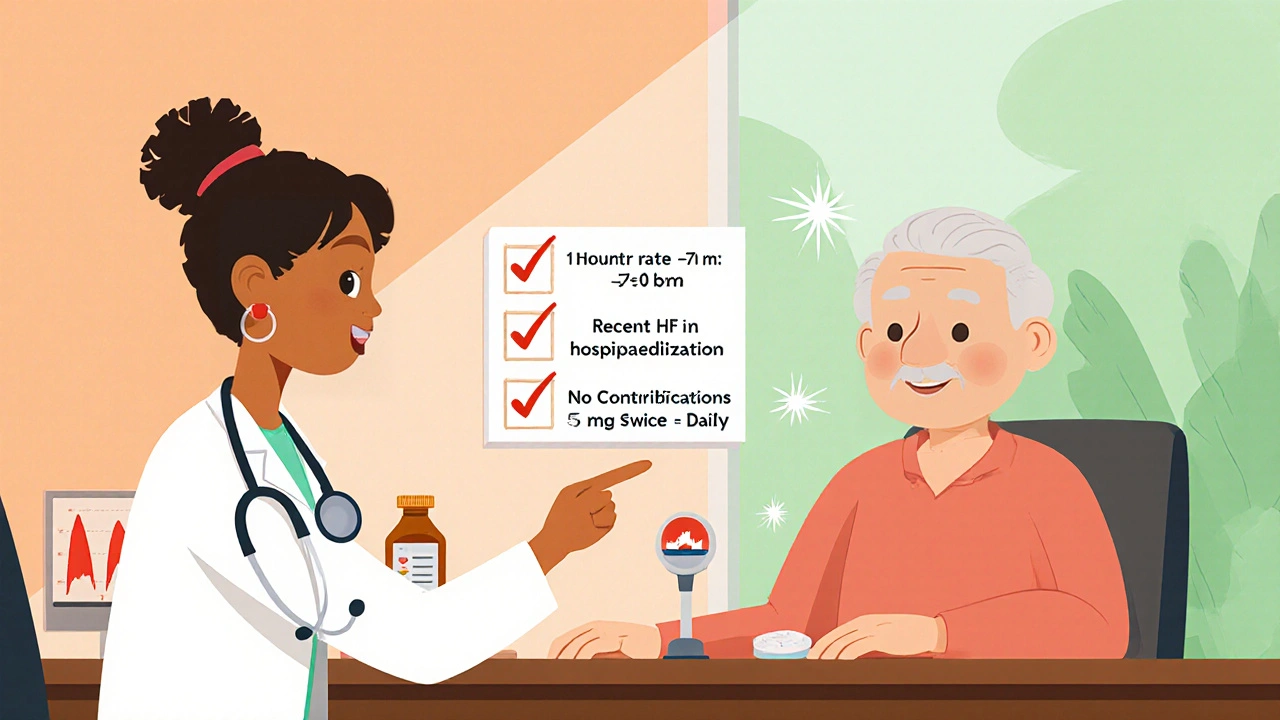
How to Apply the Evidence in Clinical Decision‑Making
When you sit down with a patient, ask three quick questions:
- Is the resting heart rate ≥70 bpm despite maximally tolerated beta‑blocker?
- Has the patient experienced a recent heart‑failure exacerbation or hospitalisation?
- Are there contraindications such as severe hypotension, sick sinus syndrome, or recent myocardial infarction?
If the answer is “yes” to the first two and “no” to the third, Ivabradine is a guideline‑recommended add‑on (Class IIa, Level A). Start with 5 mg twice daily, titrate to 7.5 mg twice daily if the heart rate remains above 60 bpm and tolerability is acceptable.
Common Pitfalls to Avoid
Even with solid trial data, mistakes happen:
- Prescribing without a beta‑blocker: Ivabradine’s benefit diminishes when used as monotherapy for heart failure.
- Ignoring the heart‑rate ceiling: Doses above 7.5 mg twice daily rarely provide extra benefit and raise the risk of bradycardia.
- Overlooking visual side‑effects: If patients report phosphenes, reassure them they are benign and usually resolve.
Future Directions and Ongoing Research
Two Phase III studies are currently recruiting:
- IVABHR - evaluating Ivabradine in patients with heart failure with preserved ejection fraction (HFpEF) and elevated heart rate.
- IVANEST - testing the drug’s role in preventing peri‑operative tachycardia in cardiac surgery.
Early data suggest that heart‑rate modulation may benefit a broader spectrum of cardiovascular disease, but results won’t be available until 2027.
Bottom Line
The evidence from SHIFT, BEAUTIFUL, and SIGNIFY is clear: Ivabradine reduces heart‑failure hospitalisations and improves outcomes when added to optimal therapy in patients with a high resting heart rate. Its safety profile is predictable, and real‑world data back up the trial results. For clinicians dealing with HFrEF or angina patients who remain tachycardic despite beta‑blockers, Ivabradine is a rational, guideline‑supported option.
What is the main benefit of Ivabradine in heart failure?
Ivabradine lowers the risk of heart‑failure hospitalisation by about 18 % when added to standard therapy in patients with a resting heart rate of 70 bpm or higher.
Can Ivabradine be used without a beta‑blocker?
Guidelines recommend Ivabradine only as an add‑on to a maximally tolerated beta‑blocker. Using it alone does not provide the same mortality benefit.
What side effects should patients expect?
The most common are harmless visual phenomena (phosphenes) and mild bradycardia. Serious events are rare, and most side effects resolve with dose adjustment.
Is Ivabradine effective for angina patients?
In the SIGNIFY trial, Ivabradine did not reduce major cardiovascular events in a broad angina population, but it helped a subgroup with heart rates ≥75 bpm. It is therefore reserved for patients who remain tachycardic despite optimal anti‑anginal therapy.
How should Ivabradine be dosed?
Start at 5 mg twice daily. If resting heart rate stays above 60 bpm and the drug is well‑tolerated, increase to 7.5 mg twice daily. Do not exceed 7.5 mg twice daily.
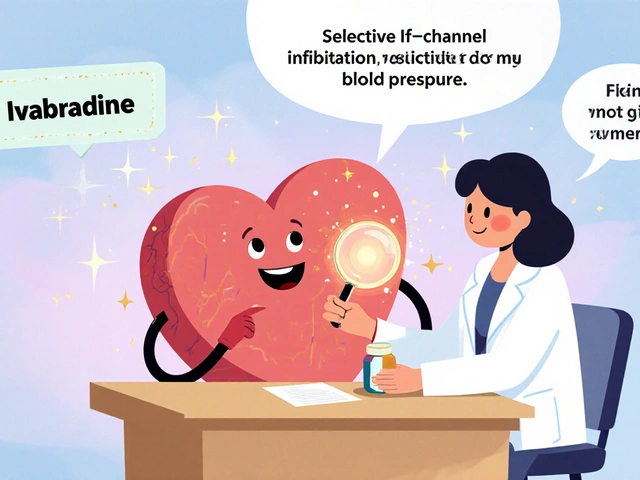
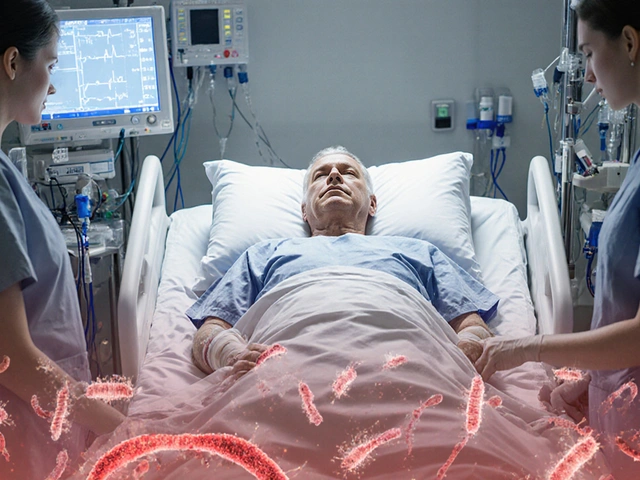

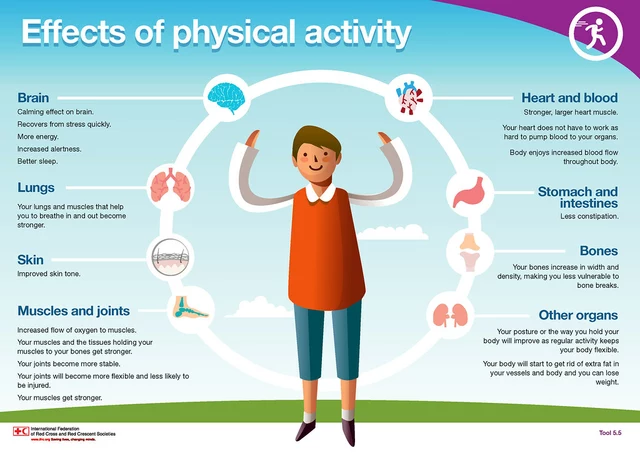





Ashok Kumar
October 21, 2025 AT 17:00So ivabradine lowers heart rate without dropping blood pressure-great, just what we needed, right? It’s nice that we finally have a tool for patients who can’t tolerate beta‑blockers.
Jasmina Redzepovic
October 25, 2025 AT 20:26Let me be crystal clear: the SHIFT trial proved that targeting the I_f channel is a paradigm shift in heart‑failure management, and any cardiologist who doubts it is simply ignoring the robust hazard‑ratio data (HR 0.82) and 95 % confidence intervals. This isn’t some peripheral European gimmick; it aligns perfectly with the ACC/AHA guidelines and underscores the necessity for evidence‑based therapeutics in our national healthcare system.
Esther Olabisi
October 29, 2025 AT 23:53Wow, another “miracle pill” that only makes you see flashes-how original! 🙄 But seriously, the visual phosphenes affect only about 11 % and most patients barely notice, so it’s not a deal‑breaker. 🌟
Ivan Laney
November 3, 2025 AT 03:20Ivabradine’s mechanism of selectively inhibiting the funny current (I_f) offers a unique way to control heart rate without compromising contractility.
This is especially valuable in heart‑failure patients who are already on maximal doses of beta‑blockers.
The SHIFT trial enrolled over six thousand patients with left‑ventricular ejection fraction ≤35 % and a resting heart rate of at least 70 bpm.
All participants were already receiving guideline‑directed medical therapy, which makes the added benefit of ivabradine even more impressive.
Over a median follow‑up of nearly twenty‑three months, the primary composite endpoint of cardiovascular death or heart‑failure hospitalization was reduced by 18 %.
The hazard ratio of 0.82 with a 95 % confidence interval of 0.71‑0.94 clearly demonstrates statistical significance.
Moreover, heart‑failure hospitalizations alone dropped by 26 %, which translates into a substantial reduction in healthcare costs.
The secondary analysis showed a modest 9 % decrease in cardiovascular mortality, indicating that the drug may also confer survival benefits.
Safety data were reassuring; the most common adverse event was luminous phosphenes, reported in about one‑tenth of patients, and only 1 % discontinued because of it.
Importantly, there were no significant effects on blood pressure, which differentiates ivabradine from many other negative‑inotropes.
The BEAUTIFUL trial, although focused on patients with coronary artery disease, further supported the benefit of heart‑rate reduction in reducing secondary outcomes like myocardial infarction.
SIGNIFY, on the other hand, highlighted that in patients without heart failure, the benefit is more modest, underscoring the need to target the right population.
Taken together, these phase‑III studies provide a robust evidence base that clinicians can rely on when considering ivabradine as an add‑on therapy.
Real‑world registries have echoed these findings, showing improved quality of life scores and exercise tolerance.
From a pharmacoeconomic standpoint, the reduction in hospital readmissions offsets the drug’s cost in many health systems.
In summary, ivabradine represents a well‑validated, mechanism‑driven option that fills an important therapeutic gap for patients with HFrEF who remain tachycardic despite optimal therapy.
Kimberly Lloyd
November 7, 2025 AT 06:46It’s uplifting to see science advance in ways that truly respect the body’s own rhythms, reminding us that medicine is as much an art as it is a science.
Erika Thonn
November 11, 2025 AT 10:13Thoghts on the ivabradine ar e sooo deep – it lowes the heart rate, but does it also lowr the soul? i guess the phosphenes are like tiny stars in the eye, a blessng or a curse 😅
Ericka Suarez
November 15, 2025 AT 13:40Oh please, another self‑appointed guru trying to sound “national” while ignoring the fact that the data still has gaps! The trial’s exclusion criteria left out thousands of real‑world patients, and that’s a drama we can’t just brush aside.
Jake Hayes
November 19, 2025 AT 17:06The primary endpoint reduction is statistically significant, but clinicians should still weigh individual tolerance and comorbidities before prescribing.
parbat parbatzapada
November 23, 2025 AT 20:33Sure, the studies look clean on paper, but who funded them? Every pharma‑backed trial hides a hidden agenda-maybe they want us all on cheap heart‑rate pills while the real cure stays hidden.
Dana Yonce
November 28, 2025 AT 00:00Looks like ivabradine could be a solid add‑on for patients who can’t tolerate higher beta‑blocker doses 😊
Lolita Gaela
December 2, 2025 AT 03:26From a pharmacodynamic perspective, ivabradine’s selective I_f inhibition modulates sinus node automaticity without affecting β‑adrenergic signaling pathways, thereby preserving inotropic reserve while achieving chronotropic reduction. This mechanistic specificity accounts for the favorable hemodynamic profile observed in both SHIFT and BEAUTIFUL cohorts.
Giusto Madison
December 6, 2025 AT 06:53For anyone considering adding ivabradine, remember to monitor heart rate closely and educate patients about the potential for visual disturbances-early awareness makes the transition smoother.